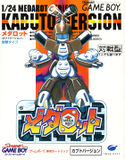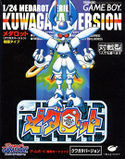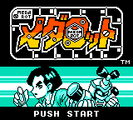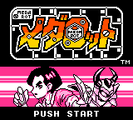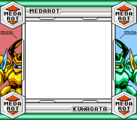Medarot 1
| Medarot メダロット | |

| |
| Genre | RPG |
|---|---|
| Platform | Nintendo Game Boy |
| Developer | Natsume |
| Publisher | Imagineer |
| Release Date | November 28, 1997 |
Medarot (also referred to as Medarot 1) is an RPG that was released in 1997 for the Nintendo Game Boy, and the original game that started the Medarot franchise. It follows Hikaru Agata on his quest to compete in Robottle tournaments and defeat the evil Roborobo Gang.
Like the other creature-collecting games of the time, Medarot 1 was released in two versions: Kabuto (Rhinoceros beetle), where the player's starting Medarot is Metal Beetle, and Kuwagata (Stag beetle), where the player starts with Head Scissors. Along with the starting Medarots, there are some Medals that can only be obtained in a specific version, and parts availability in specific shops differ. No English versions of the game were released.
Medarot 1 is a monochrome Game Boy game with only basic palette support when played on a Game Boy Color. However, it has a border and more advanced colors when played on a Super Game Boy.
A "director's cut" edition of the game titled Medarot Perfect Edition was released for Bandai's Japan-only Wonderswan system in 1999. It had two versions and was also monochrome-only. Later that year, the direct sequel Medarot 2 was released for Game Boy.
Selection of Medarots
- Main article: Medarots in Medarot 1
Medarot 1 contains 60 different Medarots (49 male, 11 female), for a total of 240 collectable parts.
Some Medarots are version exclusive, and others can only be obtained by trading (as some parts transform into different ones upon being traded; a feature removed from later games). Several Medarots are one-of-a-kind or missable, so players are encouraged to trade with other players or with one of the Parts Collections.
Differences from later games
- One of the most notable differences from the later games is the lack of Medaforce, which was introduced Medarot 2. Rather than charging MF points, the down-arrow command in battle simply makes the Medarot do nothing when it reaches the attacking line.
- During battle, the player can surrender by pressing the Select button. The ability to surrender does not reappear in any subsequent game.
- The battle screen does not display a Medarot part's HP value separately, instead only displaying the total combined value of a Medarot's parts. This would be carried over to Medarot 2 before all subsequent games started displaying the individual health value of each parts.
- Players have two opportunity to use a RoboRobo Medal: when a random battle starts, and again on the setup screen. Subsequent games only allow players to use their RoboRobo Medal at the start of the battle.
Manga
A manga series by Horuma Rin ran in Comic BomBom from mid-1997 to mid-1999. (The serialization started several months before the game's release.) It covered the entire story of the game with some changes, and was eventually collected into 3 volumes by Kodansha. An omnibus edition containing all 3 volumes was released in June 2013.
Gallery
Box art
-
Kabuto version
-
Kuwagata version
Screen
-
Title Screen (Kabuto)
-
Title Screen (Kuwagata)
-
Super Gameboy Border (Kabuto)
-
Super Gameboy Border (Kuwagata)
See also
| Video Games View - Edit | |
|---|---|
| Main series / Parts Collections |
Medarot 1 (PC / PC2) - Medarot 2 (PC) - Medarot R (PC) - Medarot 3 (PC) - Medarot 4 Medarot 5 - Medarot DS - Medarot 7 - Medarot 8 - Medarot 9 |
| Side games | Medarot Navi - Shingata Medarot - Medarot S: Unlimited Nova |
| Remakes | Medarot Perfect Edition - Medarot 2 Core |
| Action games | Metabee Shot - Medarot G - Medabots AX - Medarot Brave - Medarot Dual - Medarot Girls Mission |
| Collections | Medarot Classics - Medarot Classics Plus |
| Other games | Medarot Cardrobottle - Pocket Robottle - Robattle 3D - Medarotch |
